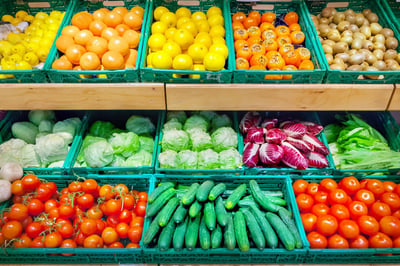Fresh food. Fast service. Local sourcing. Craft beer. Juicing. The place where all these trends intersect is the grocerant.

What, exactly, is a grocerant? It can be defined as a grocery store that incorporates a restaurant experience, inviting customers to dine and drink in-store. The grocerant trend turns a grocery store from a destination for errand-running into a “third place” where people gather between home and work.
Grocerants boost stores’ bottom lines as well. A 2016 study from the Food Marketing Institute (FMI) and Technomic suggests that 64 percent of stores saw prepared foods category growth of nine percent or higher in 2014. In addition to freshly prepared foods, what does a store need to offer to become an appealing grocerant?
Welcoming, modern décor
The traditional grocery store, with high fluorescent lights, gleaming floors, and beeping registers, doesn’t really invite people to linger. Grocerants are borrowing design motifs from fast casual restaurants to signal to customers that this is a place to sit down and get comfortable. These elements may include lowered lighting, warm colors, and distressed or reclaimed wood.
Individual restaurants inside the store
The Bryant Park Whole Foods, which opened in Manhattan in January 2017, is home to a whole collection of eateries. There’s Frankies Sputino, serving pastas, salads and sandwiches to a counter crowd. There’s Sushi Kano, which offers seasonally inspired and sustainable sushi, poke and bento on-site and to-go. And there’s Harbor Bar by Chef Daniel Boulud, with 24 beers on tap, oyster shooters and small plates. It’s all part of Whole Foods’ vision of building strategic collaborations with local chefs, Tien Ho, the vice president of culinary and hospitality, tells Eater. About 15 percent of a Whole Foods store’s sales come from its restaurants.
Wegmans operates its own restaurant concepts, such as Amore Restaurant and Wine Bar in Rochester, NY and the Seafood Bar in several Virginia locations. More than 100 Hy-Vee locations include a Market Grille, a restaurant with table service and a full bar.
Ready-to-assemble meals
While services like Blue Apron deliver fresh ingredients and recipes, grocerants make the dinner-preparing process one step easier. Wegmans touts its “EZ Meals,” which are recipes that only require throwing together two or three pre-packaged ingredients. Examples include shrimp scampi with golden potato noodles and zucchini basil puree, or cilantro-lime marinated chicken breasts with cauliflower rice and roasted vegetables. Does it count as cooking? Maybe not — but it’s an appealing option for rushed shoppers.
Freshly made juices
Juicing sits squarely in the sweet spot of grocerants — where better to get a freshly made juice than at the café right next to the produce section? Grocerant juice bars can offer specialty drinks most customers can’t easily make at home, such as cold-pressed and other raw juices; wheatgrass juice shots; and smoothies. It’s essential to buy equipment that’s powerful, compact and easy to clean, like Hamilton Beach Commercial’s wheatgrass juicer, citrus juicer and otto™ the juice extractor.
One downside to juice bars, from a customer’s perspective, is the sometimes-lengthy wait while fruits and vegetables are pressed or blended. Whole Foods seeks to solve that problem by inviting customers to text their order before they arrive.
Wine and craft beer
Eight years ago, DeCicco & Sons became the first grocer in New York State to offer an in-store bar with beer on tap. That decision proved wildly popular, and has led to accolades as well as collaborations with local brewers. Serving beer and wine in stores isn’t just an additional revenue stream; it also promotes sales elsewhere in the store because it entices shoppers to linger, Steve Thomas, chief marketing officer with in-store marketing consultancy Windsor Marketing Group, tells FoodDive.
An understanding of your customers’ desires
A grocerant can offer everything under the sun, from kombucha on tap to wood-fired pizza, but will it resonate? “Various fast casual chains tap different aspects of modern food culture through cues of freshness, quality, indulgence, discovery, experimentation, health and sustainability,” The Hartman Group observes. Grocerants, too, must decide which aspects best fit their brand and their customers’ needs, whether that’s providing full dinners for time-stressed parents or a happy-hour meetup spot for young professionals.
Among millennials, Gen X, and Gen Z shoppers, there’s no difference between supermarkets and restaurants, grocerant expert Phil Lempert tells Epicurious. “They just want to acquire food…and have the best experience they can, especially Gen Z.”
Is your company a trendsetter in the grocery or restaurant space? Tell us about it and we may feature your business in a future post.


